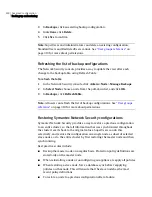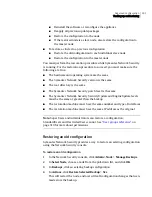
287
Advanced configuration
Establishing high availability failover
Launching from a known location
This section describes how to launch the Symantec Decoy Server console from a
known location on the network.
To launch the Symantec Decoy Server console from a known location
1
Right-click any external sensor object in the topology tree, and click
Start
Decoy Console
.
2
In
Start Decoy Console
, click
Yes
to confirm the path to the
mtadmin.jar
file.
Note:
The Symantec Decoy Server console must be closed independently of
the Network Security console. The Symantec Decoy Server console remains
open, even if you close the Network Security console.
Note:
SuperUsers and Administrators can add Smart Agents to launch Symantec
Decoy Server; all users can launch it after configuration. See
“User groups
reference”
on page 319 for more about permissions.
Establishing high availability failover
Symantec Network Security provides a number of ways to recover from
network, communication, or process failures. The Availability Monitor keeps
track of each node on the network and notifies you if the node fails or becomes
unavailable. The Watchdog Process Restart parameter keeps track of processes
on a single node. If a process fails, the failure recovery feature notes the failure
and takes action to restart that process. Failover groups, configured with the
watchdog parameters, ensure detection coverage even if a node should fail.
This section describes these topics in greater detail:
■
Monitoring node availability
■
Configuring availability for single nodes
■
Configuring availability for multiple nodes
■
Configuring watchdog processes
Monitoring node availability
Symantec Network Security provides the Availability Monitor to keep track of
each node on the network and notify you if the node fails or becomes
unavailable. The Availability Monitor attempts to connect to each node at
Summary of Contents for 10521146 - Network Security 7120
Page 1: ...Symantec Network Security Administration Guide...
Page 12: ...12 Contents Index...
Page 14: ...14...
Page 70: ...70...
Page 110: ...110 Populating the topology database Adding nodes and objects...
Page 158: ...158 Responding Managing flow alert rules...
Page 188: ...188...
Page 242: ...242 Reporting Playing recorded traffic...
Page 268: ...268 Managing log files Exporting data...
Page 316: ...316 Advanced configuration Configuring advanced parameters...
Page 318: ...318...
Page 338: ...338 SQL reference Using MySQL tables...
Page 366: ...366 Glossary...
Page 392: ...392 Index...












































